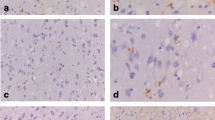Abstract.
In neurodegenerative disorders including Alzheimer's disease (AD), free radical damage to lipids, carbohydrates, proteins and DNA has been demonstrated to play a key pathogenetic role. In vitro studies have suggested a function of the cellular prion protein (PrPc) in the defense against oxidative stress. Therefore, we investigated the distribution of PrPc immunoreactivity in hippocampus (sectors CA4–CA1), subiculum (Sub), entorhinal (EC), and temporal cortex (TC) in sections from AD, human transmissible spongiform encephalopathy (TSE) and control brains. Compared to control cases, AD brains revealed an increase in the proportion of PrPc-immunoreactive neurons, which was statistically significant in CA2, Sub, and TC. In TSEs, a statistically significant increase of PrPc-immunoreactive neurons was observed in CA2, CA1, Sub, EC, and TC. In conclusion, our data show a striking up-regulation of PrPc in neurodegeneration and provide additional support for the concept that PrPc may be involved in the defense against oxidative stress.
Similar content being viewed by others
Author information
Authors and Affiliations
Additional information
Revised, accepted: 20 April 2001
Electronic Publication
Rights and permissions
About this article
Cite this article
Voigtländer, .T., Klöppel, .S., Birner, .P. et al. Marked increase of neuronal prion protein immunoreactivity in Alzheimer's disease and human prion diseases. Acta Neuropathol 101, 417–423 (2001). https://doi.org/10.1007/s004010100405
Received:
Issue Date:
DOI: https://doi.org/10.1007/s004010100405




